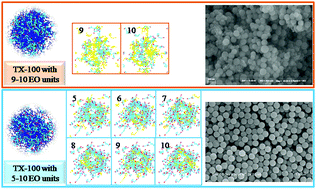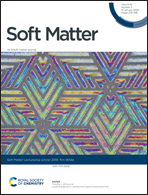A reverse micellar system with Triton X-100: effect of surfactant polydispersity and preparation of monodisperse silica nanoparticles
Abstract
Reverse micellar systems possess a characteristic nanoscale water-in-oil (w/o) structure and can offer mild conditions as a unique and versatile reaction medium. Reverse microemulsions containing water/TX-100 + hexanol/hexane are studied in this work through experimental techniques and simulation methods. Surfactant dosages and water amount affect the micellar structure profoundly, and the polydispersity of the surfactant molecules affects the micellar structure remarkably. TX-100 with 9–10 EO units can form micelles in a simply piling way, while TX-100 with 5–10 EO units endows the micelles with a hierarchical micellar interface and a more compact structure, leading to monodisperse micelles with a smaller diameter. Water in the polar cores has three states. In the reverse micellar system using TX-100 with 9–10 EO units, hydrolysis of tetraethoxysilane happens rapidly and the formed silica gels are apt to aggregate, resulting in polydisperse silica nanoparticles. For the micellar system using TX-100 with 5–10 EO units, the micellar hierarchical distributed interface facilitates the material exchange of tetraethoxysilane and limits the hydrolysis of tetraethoxysilane inside the micelles, providing monodisperse silica nanoparticles.



 Please wait while we load your content...
Please wait while we load your content...